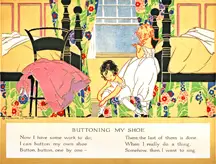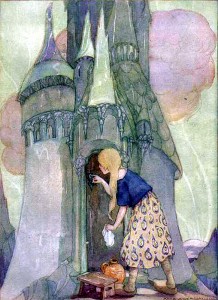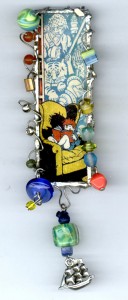
Lately, on etsy I’ve noticed a ridiculous amount of sellers of vintage materials claiming they are ‘salvaging” the beautiful plates from children’s and illustrated books and magazines. And I know that many pieces are in terrible condition, books falling apart, missing pages, written on, cracked boards, colored in black and white line drawings, scissored magazine pages . . . There is definitely a certain percentage of books out there that can be torn asunder and sold for x amount of dollars. But the shear volume of these plates lead me to the conclusion that books etc., on the borderline or in perfectly fine condition, are being pulled apart just for the plates within. And that is an unacceptable practice. At least for me.
I collect various condition children’s books for their illustrations–I make no bones about my interests. I rarely read the stories some gorgeous plates are expressing, however I’d never dream of pulling them out of a perfectly fine binding to sell individually for more profit than if the book were sold whole. This is a practice, apparently, that has been around in the UK forever. Friends there repeatedly find single prints at boot sales or bookshops. It drives me mad. I love the illustration, hate the fact that some nitwit took it out of a book to make a pathetic profit. I don’t blame people for buying them at these kind of places–the deed is done, nothing can put them back between covers. But when pirates of this sort sell on etsy or eBay, those who purchase such a print is supplying the seller with incentive to buy additional decent shape books and destroy them. I was so incensed by one eBay seller, I wrote to them, asking if they really managed to come across all the Anne Anderson, Arthur Rackham, Mabel Lucie Atwell books, in so horrible a condition, that they feel completely justified in destroying the entire book for the plates? No surprise, I received no answer. There is no possibility that dealers find illustrated books in ‘unsalvageable’ condition as a common practice. Think about it. Say an Anne Anderson book, not first edition, in decent shape, all plates accounted for, costs $75 . If there are 10 plates at $15 bucks a pop, that means they can potentially make double the money. If the book is kept intact–still $75.00. Not all plates are priced the same –some are more expensive, the more prestigious the artist, or scarce the title it could go as high has $100 for one. For minor artists, $15 down to around $8, which is the lowest I think I’ve seen.
I am fairly certain I’m in the minority when it comes to disliking this practice. Not many other people who love illustration seem bothered by it. My contention was and is, the more destroyed books, the less remain, whole, for the public to see. If each plate is sold piecemeal to various collectors, how do collectors such as myself who want ALL the plates in one package, as they were meant to be, continue to find intact books? And the rarer they become, how will I be able to afford such books?
to find intact books? And the rarer they become, how will I be able to afford such books?
I’ve used vintage illustration in jewelry, cards, writing paper, etc., some for profit, some for personal use–but I never once used the original piece. There’s this thing the company Xerox created, called a copying machine, plus now there are these fancy dancy things that scan an image that you can then print!! Imagine! These machines make it possible for one to use the gorgeous pieces found in books and never harm a sentence or brush stroke! Consider the miraculous ways in which they can be utilized this way!
In the 1980s, a talented crafter sold gorgeous pins with antique images within glass, and beading. Unfortunately, she used original pieces. Some were cigarette cards, which are of one piece, others were vintage holiday post cards, cut up with only a section used for the jewelry. At the time, I was gobsmacked, and bought two–one of an elf with pumpkin from a once gorgeous postcard, no doubt. Later, when I decided to try my hand at soldered jewelry, I remembered these pieces I bought, but realized how much I would despise cutting up postcards and other antique ephemera–so I took advantage of those new contraptions, and printed instead of mutilated.
On etsy, the other thing I’ve noticed is the stress put upon ‘original’ pieces of ephemera–meaning–a copy just won’t compete with a torn and scissored Deco Gladys Peto print. Therefore the vicious circle is complete. If the sellers of mutilated books insist that only original art can be used in ‘altered art’ or jewelry, or whatever, then those who want to be authentic ‘artists’ will seek out those who mutilate books. And both find the practice perfectly comfortable to live with.

So why am I revisiting this bugaboo of mine? Because lately myself and a friend have been gathering our collective illustrated books and ephemera, and selling it as digital downloads for those who aren’t spoilers of original pieces, to use in their craftwork. And every once in awhile, I’ll come across another seller who has heaps of separated plates for sale, and my blood starts it’s quick boil. And I keep a dream alive, that if I just keep informing people of what it is they are doing to pieces that cannot be replaced, maybe the practice will stop. In the mean time, I revel in my intact Janet Laura Scott original books, all plates accounted for. And enjoy those who love her work and would rather purchase or scan a perfectly lovely copy of an illustration to frame on their child’s wall, or for use in their craft projects, and refuse to kill another book.

I just got a set of the “My BookHouse” series and a set of the “Journey’s Through Bookland”. I grew up reading stories from books like this. I cringe at the thought of destroying these gems just to “salvage” the prints. I go out of my way to obtain these sets and hope that someone will appreciate them enough to give them a good home. I agree with you 100% – the images contained in these books are readily available without destroying perfectly good books. I would never sell one of my sets to someone if I knew that they were going to break the books apart for the plates.